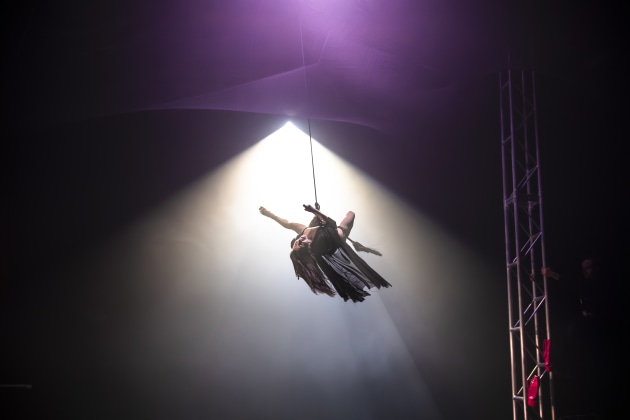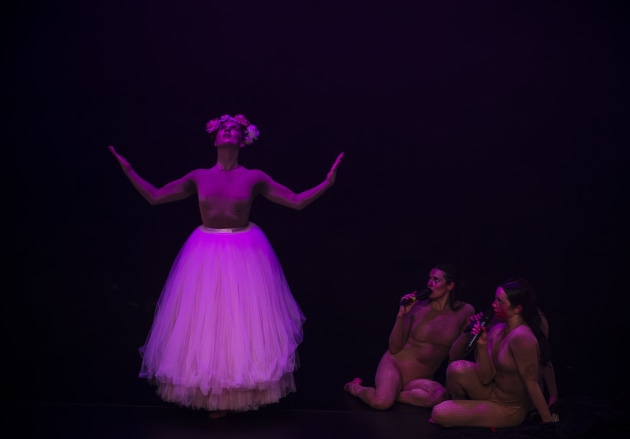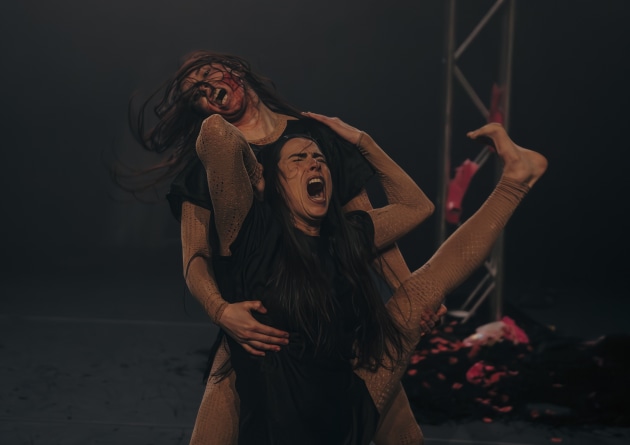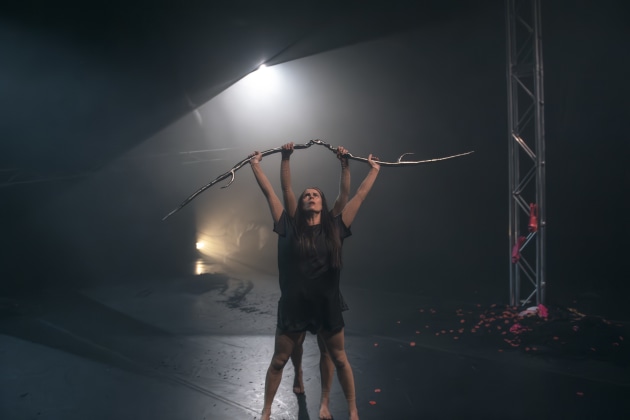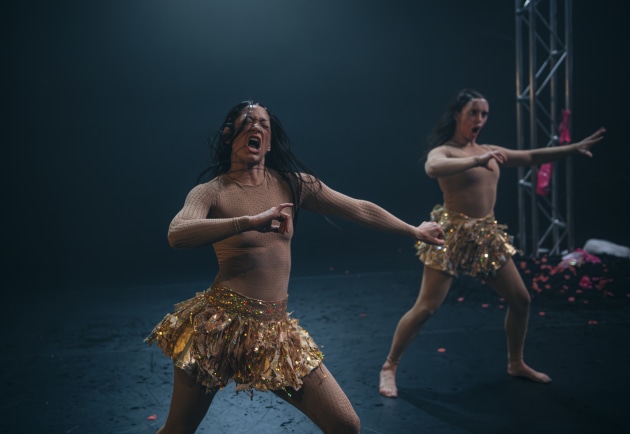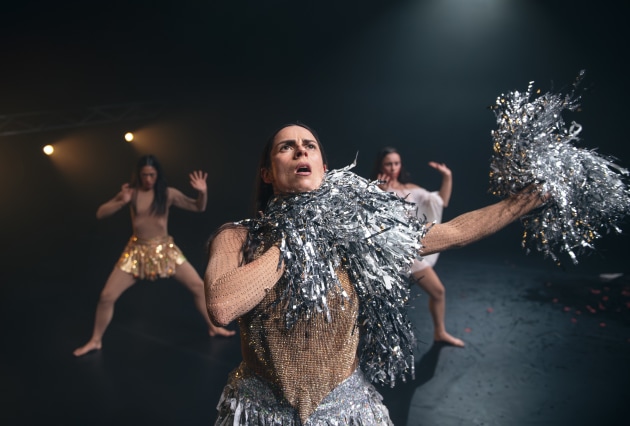Phantasm, Melanie Lane
Reviewed by Belle Beasley
Saturday 9 August 2025
Chunky Move Studios, Southbank
Dance is a notoriously hard medium to describe, operating as it does on a sensual plane that words scratch at but rarely attain. So, how to review a work that approaches dance as a portal to a world even more mysterious? This is the dilemma that I am left with after seeing Melanie Lane’s Phantasm.
Lane is an independent Australian choreographer of Javanese and European heritage, based between Naarm/Melbourne and Ngunnawal/Canberra. Her latest work, Phantasm, is a full-length contemporary dance and dance theatre piece featuring four Melbourne-based independent dance artists and a soundscape composed and performed by Melbourne-based experimental sound artist Rama Parwata. The work presents a full narrative journey across costume, lighting, set, and olfactory design to build a surreal world of dreams, memories, and otherworldly phenomena.
The work was commissioned and presented by Chunky Move as part of their Choreographer in Residence program, an initiative supporting independent choreographers over a two year period, which Lane was awarded for 2023/24. As a result, Phantasm benefited from the significant financial backing of the program – an investment of $120,000 into Lane’s practice, allowing for the deep exploration of new ideas and approaches over an extended period of time, as well as supporting the choreographer to work with a team of skilled experts to bring the vision to life.
Lane’s group of dance artists/collaborators for Phantasm consisted of Nikki Tarling, Rachel Coulson, Ashley McLellan, and Georgia Rudd, all of whom are regular names on local and national dance bills. The work began with an abstract solo from Tarling, who glided with finesse from shape to shape, persona to persona. The use of classical music in this section, Pas de Quatre by Pugni, coalesced with Tarling’s matter-of-fact movement quality to produce a sense of disquiet, almost obligation. The energy shifted when Coulson joined the stage. Costumes became flowing silhouettes and eventually came off, bodies softened, and movement sequences emerged from desire rather than force. The sense of romance between the two, somehow passionate and platonic, became a nostalgic allegory for all great loves – between mother and daughter, best friends, lovers.
McLellan’s entry took Phantasm’s world from nostalgic to surreal, as she twisted and contorted with a power almost god-like (thinking back to Lane’s choreographic interest in Greek mythology and the sense that McLellan would make a fantastic Medusa). The three artists moved together through a series of increasingly absurd tableaus, shape-shifting into scary cheerleaders dancing with a violence akin to that of Paul Verhoeven’s Showgirls. Their pom-poms morphed into sprinkling snowflakes, recalling The Nutcracker’s iconic Waltz of the Snowflakes but more dystopian – I felt almost as if the snowflakes were the aftermath of an apocalyptic explosion.
Becoming fixated on sweeping up the snowflakes whilst grumbling aloud with disgust, the dancers then surreptitiously stepped into harnesses and morphed into witches, hoisted in the air on their brooms. The seamlessness of this transformation, from hysterical housemaids to cackling cronies, was genius and rendered the audience – for want of a better word – gagged.
The work’s final chapter introduced Rudd as a cotton-candy-coloured Giselle-like Willis, with the rest of the cast crouching in the corner holding microphones from which we could discern the barely audible mumblings of lyrics from Nicki Minaj’s verse on Kanye West’s Monster. Donning tutus to join Rudd, the group bourée-d around the stage with a sugar-coated quality, exaggerating the classical ballet references with sickly-sweet femininity and floral headpieces reminiscent of Lana del Ray.
Rama Parwata’s energising soundscape was visceral as it was haunting, and enhanced further by the live on-stage connection between him and the dancers. Shape-shifting silhouettes by costume designer Paula Levis and energy amplifying lighting design by Bosco Shaw were both executed exceptionally and were crucial in building Phantasm’s world. However, Lane extended the regular production considerations to incorporate two unusual elements.
Set, video and olfactory designer Eugyeene Teh’s creations for the work were the quiet but impactful stars of the show, with the scent design in particular producing a powerful effect. The heady and hypnotising waft emanating from the stage seemed to change with every new scene and created a true multi-sensory experience on top of what already felt like a hallucination.
Scent seems to be attracting more and more artists at the moment as a material with which to manipulate the experiential – thinking to recent exhibitions of a powerfully linseed oil-scented wooden sculpture by Lidia Clark and Charlie Rogers at 138 Gallery, and Joshua Petherick and Lewis Fidock’s hairspray-infused exhibition of wig sculptures at Connors Connors. Lane’s incorporation of scent in her choreography for Phantasm signals an interesting direction for theatre work, eschewing new technologies like augmented or visual reality to instead play with the potency of aroma as choreographic material.
The other unusual but powerful element in the show was a metal double-ended spike sculpture constructed by Melbourne-based artist Jemima Lucas, which appeared several times throughout the work. The spike, wielded carefully and ominously, became another absurd talisman in a work full of symbols, and the sculpture’s commanding materiality offered an interesting counterpoint to the more ephemeral elements of the work.
Phantasm’s journey was rich, evocative, and full of ambiguity. This is a work that can only be described as a black hole, using dance to poke at cracks in reality and engulf us in the sublime and incomprehensible mysteries that lie beyond.
Phantasm runs until 16 August at Chunky Move Studios. Tickets available here.
-Belle Beasley



